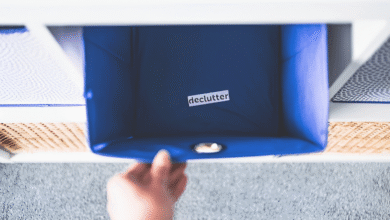How to Organize Your Digital Life in 7 Days
Organize your digital life in 7 days. Declutter files, secure passwords & boost productivity with this step-by-step guide. Start now.

Organizing your digital life is no longer optional it’s essential for productivity, security, and peace of mind. With endless files, emails, passwords, and apps scattered across devices, Digital Life clutter can quickly spiral out of control. But what if you could completely organize your Digital Life in just one week? This step-by-step guide breaks down the process into manageable daily tasks, helping you declutter, secure, and streamline your Digital Life efficiently. By the end of 7 days, you’ll have a system that saves time, reduces stress, and keeps your data protected.
The modern Digital Life demands organization, yet most people struggle with disorganized files, overflowing inboxes, and forgotten passwords. Without a proper system, important documents get lost, cybersecurity risks increase, and daily tasks become needlessly frustrating. This guide provides a clear, structured approach to organizing your digital life, ensuring everything from cloud storage to social media accounts is optimized. Whether you’re a busy professional, a student, or simply someone drowning in Digital Life, this 7-day plan will help you regain control one step at a time.
How to Organize Your Digital Life in 7 Days
Audit Your Digital Files
The first step to organizing your digital life is assessing what you have. Start by reviewing files on your computer, cloud storage, and external drives. Delete duplicates, outdated documents, and unnecessary downloads. Use folders with clear labels like “Work,” “Personal,” and “Finance” to categorize files. Tools like Google Drive, Dropbox, or OneDrive can help automate backups. A well-structured file system saves time and prevents frustration when searching for important documents.
Declutter Your Email Inbox
A flooded inbox is a major source of stress. Begin by unsubscribing from newsletters you no longer read. Create filters to automatically sort incoming emails into folders like “Urgent,” “Read Later,” and “Promotions.” Use tools like Gmail’s categories or Outlook’s rules to streamline the process. Aim for inbox zero by archiving or deleting old messages. A clean inbox improves focus and ensures you never miss critical emails.
Organize Your Passwords
Weak or repeated passwords put your digital security at risk. Use a password manager like LastPass, 1Password, or Bitwarden to store and generate strong passwords. Enable two-factor authentication (2FA) for added security. Update passwords for high-risk accounts like banking and email first. A secure password system protects you from cyber threats while making logins effortless.
Clean Up Your Digital Photos & Media
Photos and videos often take up significant storage. Sort through your gallery, deleting blurry or duplicate images. Use cloud services like Google Photos or iCloud for automatic backups. Create albums for events, trips, and important moments. A well-organized media library makes it easier to find cherished memories.
Automate Backups & Security
Data loss can be devastating. Set up automatic backups for critical files using Time Machine (Mac), Windows Backup, or cloud services. Install reliable antivirus software to protect against malware. Regularly check privacy settings on social media and other accounts. A strong backup and security strategy ensures peace of mind.
Streamline Your Apps & Software
Most people have apps they rarely use. Review your smartphone, tablet, and computer applications. Delete unused apps and organize the remaining ones into folders by function e.g Social Media, Productivity. Update software to the latest versions to avoid security vulnerabilities. A minimalistic app setup reduces distractions and improves device performance.
Maintain Your Digital Organization
Establish a Weekly Review Routine
Set aside 30 minutes every Friday to quickly audit your systems. Check for new file clutter, unsubscribe from fresh email subscriptions, and verify your backups are running properly. This proactive maintenance prevents small messes from becoming overwhelming.
Leverage Automation Wherever Possible
Enable auto-archiving for old emails, set cloud storage to sync important folders automatically, and use calendar reminders for password updates. Automation handles the repetitive tasks so you can focus on what matters.
Practice Digital Minimalism Daily
Before downloading new apps or saving files, ask: “Do I really need this?” Adopt a one-in-one-out policy for apps and regularly empty your downloads folder. This mindset shift keeps your digital space lean and functional long-term.
Stay Security-Conscious
Make it a habit to check for software updates every Monday and review privacy settings monthly. Quick security checks ensure your organized systems remain protected against new threats.
Celebrate and Refine Your System
After 30 days, assess what’s working and tweak what isn’t. Reward yourself for maintaining your digital organization – the positive reinforcement helps turn these habits into second nature.
Challenges of Organizing Your Digital Life in 7 Days
Overcoming Digital Hoarding Tendencies
Many users struggle to delete old files, emails, or apps due to emotional attachments or “just in case” thinking. This makes initial decluttering phases time-consuming and mentally taxing. Breaking this scarcity mindset requires conscious effort and practical deletion criteria.
Time Management During the Process
Busy professionals often underestimate the hours needed for proper organization. Between file sorting, password updates, and system backups, each day’s task can spill over if not properly scheduled. Setting realistic time blocks is crucial for staying on track.
Technical Learning Curves
Implementing password managers, cloud backups, or automation tools presents hurdles for less tech-savvy users. The initial setup of new systems often takes longer than expected, potentially derailing the 7-day timeline without proper guidance or tech support.
Maintaining Consistency Post-Challenge
The real test comes after day 7 many revert to old habits without systems for ongoing maintenance. Without scheduled check-ins or accountability measures, digital clutter quickly reaccumulates, negating initial progress.
Security Trade-Offs During Transition
While reorganizing, users may temporarily expose sensitive data or use weak passwords during system migrations. This vulnerable transition period requires careful planning to avoid creating new security risks while solving old ones.
Cross-Device Synchronization Issues
With files scattered across smartphones, tablets, and computers, achieving unified organization proves difficult. Platform incompatibilities and sync delays often disrupt the seamless system users hope to create within the tight timeframe.
Decision Fatigue From Constant Prioritization
The 7-day format demands hundreds of micro-decisions about file importance, app usefulness, and storage solutions. This mental load causes many to abandon the process prematurely or make inconsistent organization choices.
Unexpected Technical Glitches
Corrupted files during transfers, failed backups, or software conflicts can derail progress. These unplanned troubleshooting sessions consume valuable time originally allocated for organization tasks.
Emotional Resistance to Change
Established digital workflows however inefficient provide subconscious comfort. The psychological resistance to adopting new systems often surfaces midway through the challenge, requiring motivation techniques to push through.
Read More: How to File Business Taxes Without a CPA
Conclusion
Organizing your digital life in just 7 days may seem ambitious, but with this structured approach, it’s completely achievable. By dedicating focused time each day to decluttering files, securing passwords, and automating backups, you’ll transform the chaos into an efficient, stress-free digital ecosystem. The benefits extend far beyond just neat folders you’ll gain hours of reclaimed time, stronger security, and the mental clarity that comes with true Digital Life organization.
The key to maintaining an organized digital life is consistency. Treat this 7-day reset as a springboard for lasting habits rather than a one-time cleanup. Schedule monthly check-ins to delete unused files, update passwords, and reassess your systems. With these strategies in place, you’ll enjoy a streamlined Digital Life experience that supports rather than hinders your productivity and peace of mind for years to come.
FAQs
How do I start organizing my digital life?
Begin by auditing all devices and cloud storage, deleting unnecessary files, and creating a logical folder structure for easy access.
What’s the best way to manage email overload?
Unsubscribe from unused newsletters, set up filters/labels, and aim for inbox zero by archiving or deleting old messages regularly.
Are password managers really secure?
Yes, reputable password managers (like Bitwarden or 1Password) use encryption and two-factor authentication for maximum security.
How often should I back up my files?
Automate weekly backups for critical files and do a full system backup monthly to prevent data loss.
What’s the easiest way to maintain digital organization?
Schedule 15-minute weekly cleanups to delete clutter, update passwords, and reorganize files before they pile up again.







